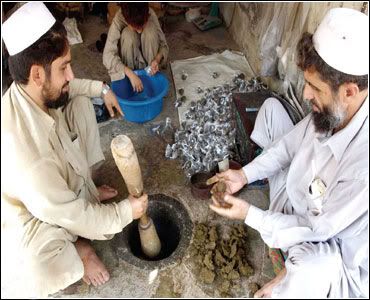Naswar and Punjab
By
Imran Khan
My good friend and former colleague Dr. Adnan Haider is a dedicated economist. His facebook timeline is a steady stream of the latest happenings in the world of economics, he also shares a lot of his own findings as well. It is one such findings that I found particularly interesting. The graph below is courtesy of Dr. Haider.
One thing that should jump out from this is the per-capita expenditure on Naswar; according to the Household Integrated Economic Survey 2013-14, Punjab’s households had a higher expenditure on Naswar than those in Khyber Pakhtunkhwa. Let that sink in for a bit, we are accounting for the population differences between Punjab and Khyber Pakhtunkhwa, but still Naswar consumption seem to be higher for Punjab. How could that be?
There could be many explanations for it, one could be that prices of Naswar might be higher in Punjab so even though the consumption is less, thanks to the higher prices the consumption in Punjab seems to be higher. To find out more, I asked for help on twitter and got responses from Karachi, Peshawar and Islamabad/Rawalpindi. In all three areas the price seem to be Rs. 10 per little packet of Naswar. So it is safe to assume that prices might not be exorbitantly high in Punjab when compared with Khyber Pakhtunkhwa.
Another explanation, would be to say that Punjab always consumed more naswar than Khyber Pakhtunkhwa. To make sure, one has to dig back and there actually is a HIES of 2003-04 which could be analyzed to find out that answer. I currently don’t have that dataset, but would definitely update this blogonce I get a hold of that. The conclusion in that case would go contrary to years of stereotyping, not that it would be a bad thing but facts on the ground might indicate otherwise. For instance, take a look at this one study from 2007, which was aimed at medical students across Pakistan. The study’s aim was to determine the type of “smokeless tobacco” use prevalent among these students. Around 4% of the sample admitted to using naswar, and 87.9% of those students hailed from Khyber Pakhtunkhwa. This particular study might be weak in design, but throw in the anecdotal evidence and it confirms what most would tend to agree with i.e. a Pashtun is more likely to be a naswar consumer than a Punjabi.
So what’s going on with Dr. Haider’s graph? One explanation that I am leaning towards is that this consumption just might be a proxy for the rising proportion of Pashtuns in Punjab. I am not saying that most of KP has moved into Punjab, because that bar of naswar consumption for Punjab must definitely have a substantial number of Punjabis as well. But then a higher naswarconsumption among Punjabis might be because of the availability of naswar thanks to the rising number of Pashtun in Punjab.
Here too anecdotal evidence indicates that the 15 year long war on terror in Khyber Pakhtunkhwa and FATA that was accompanied by bombings and more importantly kidnappings have forced a substantial number of the Pashtuns to move south towards Islamabad and Punjab.
The upcoming census might have surprises on the new ethniccomposition of our cities, especially in Punjab. And this is important given our obsession with our beloved “strategic assets” aka Taliban and our national priorities focused onPakistan-proper (read Punjab).
Those who think that the cost of harboring “strategic assets”could be kept limited to FATA and Khyber Pakhtunkhwa need to realize that the more KP and FATA remains unstable, the more the people of that region will crowd into Punjab. While they bring money, expertise and labour with them, these inflows are also destabilizing the ethnic composition of their new home cities. The world is replete with examples where such large scale migrations are followed by ethnic frictions and often conflict. The official harassment of Pashtuns in Punjab, under the guise of security concerns, has already started and is justified quite unabashedly by Chaudhry Nisar. But it should be obvious that those who are running away from abductions, beheadings, target killings and bombings can’t be discouraged by mere police harassment. As long as visas for Pakistani Pashtuns are not a consideration, these migrations will continue.
One could argue that security in KP and FATA and a revival of its economy is as important for Pashtuns as it is for Punjabis. That is because the rising number of Pashtuns in Punjab is a cost that Punjab is paying for Pakistan’s strategic assets. While it might pale in comparison to what KP and FATA has paid, it is still a cost that Punjab should be worried about.
Here is to hope that our establishment and its Punjab centric priorities should include the aim to bring down Punjab’s naswarconsumption, by making sure that FATA and KP become livable again. While the Taliban could be convinced to look away fromPunjab, discouraging the average Pakistani Pashtun to exercise his constitutional right of settling in Punjab might be much more difficult.


No comments:
Post a Comment